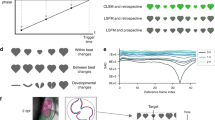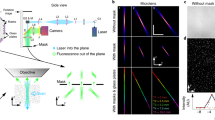Abstract
Time-lapse confocal microscopy of mouse embryo slices was developed to access and image the living aorta. In this paper, we explain how to label all hematopoietic and endothelial cells inside the intact mouse aorta with fluorescent directly labeled antibodies. Then we describe the technique to cut nonfixed labeled embryos into thick slices that are further imaged by time-lapse confocal imaging. This approach allows direct observation of the dynamic cell behavior in the living aorta, which was previously inaccessible because of its location deep inside the opaque mouse embryo. In particular, this approach is sensitive enough to allow the experimenter to witness the transition from endothelial cells into hematopoietic stem/progenitor cells in the aorta, the first site of hematopoietic stem cell generation during development. The protocol can be applied to observe other embryonic sites throughout mouse development. A complete experiment requires ∼2 d of practical work.
This is a preview of subscription content, access via your institution
Access options
Subscribe to this journal
Receive 12 print issues and online access
$259.00 per year
only $21.58 per issue
Buy this article
- Purchase on Springer Link
- Instant access to full article PDF
Prices may be subject to local taxes which are calculated during checkout





Similar content being viewed by others
References
Bertrand, J.Y. et al. Haematopoietic stem cells derive directly from aortic endothelium during development. Nature 464, 108–111 (2010).
Kissa, K. & Herbomel, P. Blood stem cells emerge from aortic endothelium by a novel type of cell transition. Nature 464, 112–115 (2010).
Kissa, K. et al. Live imaging of emerging hematopoietic stem cells and early thymus colonization. Blood 111, 1147–1156 (2008).
Cumano, A. & Godin, I. Ontogeny of the hematopoietic system. Annu. Rev. Immunol. 25, 745–785 (2007).
Dzierzak, E. & Speck, N.A. Of lineage and legacy: the development of mammalian hematopoietic stem cells. Nat. Immunol. 9, 129–136 (2008).
Muller, A.M., Medvinsky, A., Strouboulis, J., Grosveld, F. & Dzierzak, E. Development of hematopoietic stem cell activity in the mouse embryo. Immunity 1, 291–301 (1994).
Medvinsky, A. & Dzierzak, E. Definitive hematopoiesis is autonomously initiated by the AGM region. Cell 86, 897–906 (1996).
Dieterlen-Lievre, F., Pouget, C., Bollerot, K. & Jaffredo, T. Are intra-aortic hemopoietic cells derived from endothelial cells during ontogeny? Trends Cardiovasc. Med. 16, 128–139 (2006).
Gekas, C., Dieterlen-Lievre, F., Orkin, S.H. & Mikkola, H.K. The placenta is a niche for hematopoietic stem cells. Dev. Cell 8, 365–375 (2005).
Ottersbach, K. & Dzierzak, E. The murine placenta contains hematopoietic stem cells within the vascular labyrinth region. Dev. Cell 8, 377–387 (2005).
Christensen, J.L., Wright, D.E., Wagers, A.J. & Weissman, I.L. Circulation and chemotaxis of fetal hematopoietic stem cells. PLoS Biol. 2, E75 (2004).
Jaffredo, T., Gautier, R., Eichmann, A. & Dieterlen-Lievre, F. Intraaortic hemopoietic cells are derived from endothelial cells during ontogeny. Development 125, 4575–4583 (1998).
Ma, X., Robin, C., Ottersbach, K. & Dzierzak, E. The Ly-6A (Sca-1) GFP transgene is expressed in all adult mouse hematopoietic stem cells. Stem Cells 20, 514–521 (2002).
de Bruijn, M.F. et al. Hematopoietic stem cells localize to the endothelial cell layer in the midgestation mouse aorta. Immunity 16, 673–683 (2002).
Zhang, J. et al. CD41-YFP mice allow in vivo labeling of megakaryocytic cells and reveal a subset of platelets hyperreactive to thrombin stimulation. Exp. Hematol. 35, 490–499 (2007).
Emambokus, N.R. & Frampton, J. The glycoprotein IIb molecule is expressed on early murine hematopoietic progenitors and regulates their numbers in sites of hematopoiesis. Immunity 19, 33–45 (2003).
Ferkowicz, M.J. et al. CD41 expression defines the onset of primitive and definitive hematopoiesis in the murine embryo. Development 130, 4393–4403 (2003).
Matsubara, A. et al. Endomucin, a CD34-like sialomucin, marks hematopoietic stem cells throughout development. J. Exp. Med. 202, 1483–1492 (2005).
Mikkola, H.K., Fujiwara, Y., Schlaeger, T.M., Traver, D. & Orkin, S.H. Expression of CD41 marks the initiation of definitive hematopoiesis in the mouse embryo. Blood 101, 508–516 (2003).
Robin, C., Ottersbach, K., Boisset, J.C., Oziemlak, A. & Dzierzak, E. CD41 is developmentally regulated and differentially expressed on mouse hematopoietic stem cells. Blood 117, 5088–5091 (2011).
Boisset, J.C. et al. In vivo imaging of haematopoietic cells emerging from the mouse aortic endothelium. Nature 464, 116–120 (2010).
Boisset, J.C. & Robin, C. Imaging the founder of adult hematopoiesis in the mouse embryo aorta. Cell Cycle 9, 2487–2488 (2010).
Swiers, G., Speck, N.A. & de Bruijn, M.F. Visualizing blood cell emergence from aortic endothelium. Cell Stem Cell 6, 289–290 (2010).
Lam, E.Y., Hall, C.J., Crosier, P.S., Crosier, K.E. & Flores, M.V. Live imaging of Runx1 expression in the dorsal aorta tracks the emergence of blood progenitors from endothelial cells. Blood 116, 909–914 (2010).
Jones, E.A. et al. Dynamic in vivo imaging of postimplantation mammalian embryos using whole embryo culture. Genesis 34, 228–235 (2002).
Yamanaka, Y., Tamplin, O.J., Beckers, A., Gossler, A. & Rossant, J. Live imaging and genetic analysis of mouse notochord formation reveals regional morphogenetic mechanisms. Dev. Cell 13, 884–896 (2007).
Yamamoto, C. & McIlwain, H. Electrical activities in thin sections from the mammalian brain maintained in chemically-defined media in vitro. J. Neurochem. 13, 1333–1343 (1966).
Oertner, T.G. Functional imaging of single synapses in brain slices. Exp. Physiol. 87, 733–736 (2002).
Chvatal, A. et al. Three-dimensional confocal morphometry reveals structural changes in astrocyte morphology in situ. J. Neurosci. Res. 85, 260–271 (2007).
Gahwiler, B.H., Capogna, M., Debanne, D., McKinney, R.A. & Thompson, S.M. Organotypic slice cultures: a technique has come of age. Trends Neurosci. 20, 471–477 (1997).
Wang, X. et al. Asymmetric centrosome inheritance maintains neural progenitors in the neocortex. Nature 461, 947–955 (2009).
Molyneaux, K.A., Stallock, J., Schaible, K. & Wylie, C. Time-lapse analysis of living mouse germ cell migration. Dev. Biol. 240, 488–498 (2001).
Thevenaz, P., Ruttimann, U.E. & Unser, M. A pyramid approach to subpixel registration based on intensity. IEEE Trans. Image Process 7, 27–41 (1998).
Acknowledgements
We thank the 'Experimentele Medische Instrumentatie' Department of the Erasmus Medical Center and P. Hartwijk for building the black round plastic disks. We also thank R. Koppenol from Cluster 15 of the Erasmus Medical Center for the pictures. This work was supported by NWO (Vidi Dutch young investigator grant [917-76-345]). We thank N. Galjart for careful reading of the manuscript.
Author information
Authors and Affiliations
Contributions
C.R. and C.A.-S. developed the nonfixed embryo slicing. C.R., J.-C.B. and W.A.v.C. developed the time-lapse confocal imaging procedure of nonfixed embryo slices/embryo caudal parts. C.R. and J.-C.B. developed and performed the described protocol. All authors wrote the paper. T.C. filmed and edited the three movies showing the experimental procedure.
Corresponding author
Ethics declarations
Competing interests
The authors declare no competing financial interests.
Supplementary information
Supplementary Fig. 1
Multicolor staining of embryo slices with directly labeled antibodies. E11 Ly-6A-GFP embryo slice stained with the indicated antibodies directly labeled with phycoerythrin (PE) (red) and Alexa Fluor 647 (blue). GFP signal (green). The merged image is shown with and without the transmitted light. Image orientation: ventral side of the embryo to the left. Scale bar: 10 μm. Mice must be housed according to institutional guidelines and all animal procedures must be carried out in compliance with the standards for humane care and use of laboratory animals. (TIFF 22630 kb)
Supplementary Fig. 2
Time-lapse confocal imaging and staining of the embryo slices. (a) The culture chamber is placed on the microscope heated stage and (b) covered with the lid of a 30 mm cm culture dish and with a transparent lid. (c) After removing the culture chamber from the microscope, remove the myeloid long-term medium from the top of the gel and place the gel with the help of a curved forceps on the lid of a 60 mm culture dish (the bottom of the gel is placed up). The antibody dilution is placed on the top of the gel. Mice must be housed according to institutional guidelines and all animal procedures must be carried out in compliance with the standards for humane care and use of laboratory animals. (TIFF 23756 kb)
Supplementary Movie 1
Supplementary Movie 1 shows the embryo caudal part (separated from the dorsal tissue) stained with FITC anti-CD45 (green), PE anti-c-kit (red) and Alexa Fluor 647 anti-CD31 (blue). The video shows the sequential scanning images (merged of transmitted light and fluorescent channels) along the z-axis (40x lens). (MOV 1809 kb)
Supplementary Movie 2
Supplementary Movie 2 shows the closing of the aortic lumen during time-lapse confocal imaging of E10 embryo slice performed in medium (10x lens; merge of transmitted light and anti-CD31 staining (red)). Ventral side of the aorta upwards. (MOV 5186 kb)
Supplementary Movie 3
Supplementary Movie 3 shows the embryo dissection procedure. (MOV 7748 kb)
Supplementary Movie 4
Supplementary Movie 4 shows the intra-aortic injection procedure. (MOV 8905 kb)
Supplementary Movie 5
Supplementary Movie 5 shows the embryo slicing procedure. (MOV 9289 kb)
Rights and permissions
About this article
Cite this article
Boisset, JC., Andrieu-Soler, C., van Cappellen, W. et al. Ex vivo time-lapse confocal imaging of the mouse embryo aorta. Nat Protoc 6, 1792–1805 (2011). https://doi.org/10.1038/nprot.2011.401
Published:
Issue Date:
DOI: https://doi.org/10.1038/nprot.2011.401
This article is cited by
-
In vivo generation of haematopoietic stem/progenitor cells from bone marrow-derived haemogenic endothelium
Nature Cell Biology (2019)
-
Single-cell transcriptomics reveal the dynamic of haematopoietic stem cell production in the aorta
Nature Communications (2018)
-
EphrinB2 regulates the emergence of a hemogenic endothelium from the aorta
Scientific Reports (2016)
-
Pharmacological manipulation of blood and lymphatic vascularization in ex vivo–cultured mouse embryos
Nature Protocols (2012)
-
Studying cell behavior in whole zebrafish embryos by confocal live imaging: application to hematopoietic stem cells
Nature Protocols (2011)
Comments
By submitting a comment you agree to abide by our Terms and Community Guidelines. If you find something abusive or that does not comply with our terms or guidelines please flag it as inappropriate.



